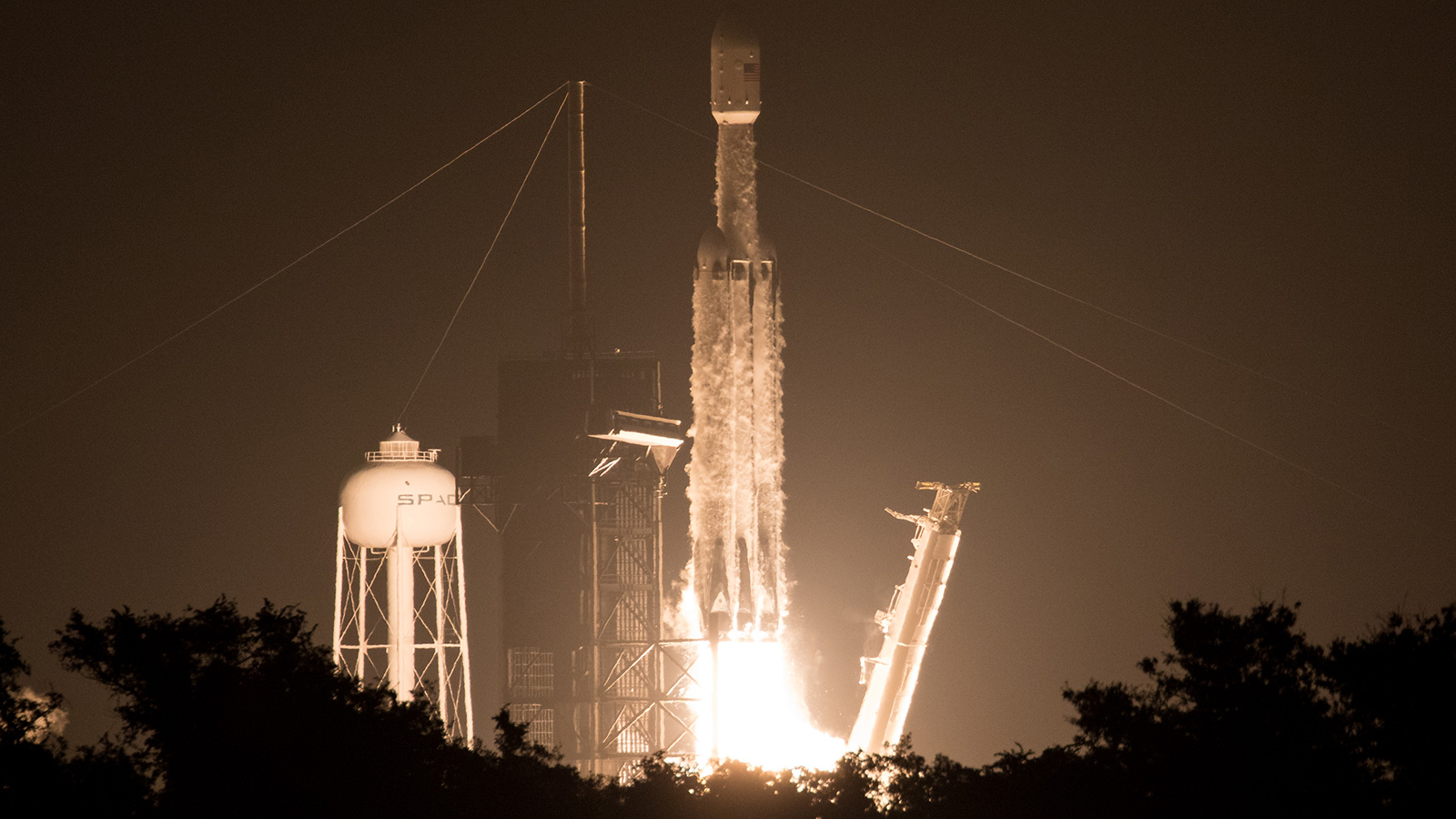
Updated at 11:50 PDT (2:50 p.m. EDT) on June 24: The SpaceX Falcon Heavy rocket launched at 11:30 p.m. PDT (2:30 a.m. EDT).
Later today, if all goes as expected, Earth will rumble and the night will light up as a SpaceX Falcon Heavy rocket launches from Cape Canaveral, Florida, carrying new NASA technology. That includes a technology demonstration from NASA’s Jet Propulsion Laboratory in Pasadena, California, to improve deep space navigation, as well as other instruments to benefit spacecraft design and climate research. Here are a few things to know about the technologies and their host satellites:
An Atomic Clock for Self-Driving Spacecraft
What if a spacecraft could fly itself? A team at JPL is trying to make those sci-fi dreams a reality by launching a small instrument with big implications. NASA’s Deep Space Atomic Clock is similar to the atomic clocks found in GPS satellites but 50 times more stable. The technology will be a critical part of onboard navigation systems for future spacecraft and will work like the GPS you have in your car.
This represents a leap forward from today’s space travel, which doesn’t benefit from the GPS system used to navigate on Earth. Instead, human navigators guide spacecraft using signals that can take from minutes to hours to deliver directions. If the clock’s one-year technology demonstration goes well, future Deep Space Atomic Clocks could guide humans to Mars, even providing them GPS on the surface.
The Orbital Test Bed satellite that hosts the Deep Space Atomic Clock is expected to be released into orbit about 11/2 hours after launch. Mission managers anticipate it will take around four to seven weeks after launch for the clock to be fully powered on and several months before scientists can analyze its performance.
Credits: U.S. Air Force Space and Missiles Systems Center/SpaceX
Weather and Climate-Observing Satellites
A flock of six satellites will fly over the tropics, getting a birds-eye view of climate change and weather patterns by measuring vital data such as temperature and water vapor in the atmosphere. COSMIC-2 — short for Constellation Observing System for Meteorology, Ionosphere, and Climate — is a joint mission between the National Oceanic and Atmospheric Administration (NOAA) and Taiwan’s Ministry of Science and Technology, a summer sequel to the COSMIC weather and climate satellites that launched in 2006. JPL engineers made the radio occultation receiver for COSMIC-2, which will let the satellites measure humidity and air temperature closer to the ground and with more accuracy than previous generations.
The six satellites are expected to deploy shortly after the Orbital Test Bed satellite.
JPL’s Grand Phaeton Finale
The Phaeton Mast Dynamics Central Assembly (PCA) is a small, cube-like accelerometer that measures the vibrations of a spacecraft’s mast, which is similar to the mast of a ship. Built 10 years ago as the first project in JPL’s Phaeton program, a training ground for recently-graduated engineers, the instrument will take its very first journey into space aboard the Air Force Research Laboratory’s Demonstration and Science Experiments (DSX) mission.
DSX will study how spacecraft withstand the harsh radiation of medium-Earth orbit. At the same time, the accelerometer will measure how antennas and masts weather the conditions of space, information that will help improve their longevity. The PCA will also measure how well antennas and masts transition from a folded launch position to being fully extended in orbit. This data will help engineers design better deployable masts, bringing us that much closer to sturdier spacecraft that can venture farther into space.
In addition, the DSX satellite is carrying the Space Environment Testbeds (SET) mission from NASA’s Goddard Space Flight Center in Greenbelt, Maryland, which will study how to protect satellites from the harsh environment of space. DSX is expected be released last, around 31/2 hours after launch.
Project Information
The Deep Space Atomic Clock is hosted on a spacecraft provided by General Atomics Electromagnetic Systems of Englewood, Colorado. It is sponsored by the Technology Demonstration Missions program within NASA’s Space Technology Mission Directorate and the Space Communications and Navigations program within NASA’s Human Exploration and Operations Mission Directorate. JPL manages the project.
COSMIC-2 is a partnership between NOAA, the U.S. Air Force, JPL, Taiwan’s National Space Organization, the United Kingdom’s Surrey Satellite Technology Limited, the Brazil Institute of Space Research and the Australia Bureau of Meteorology. This six-satellite constellation will provide next-generation Global Navigational Satellite System Radio Occultation (GNSS-RO) data. Radio occultation data is collected by measuring the changes in a radio signal as it is refracted in the atmosphere, allowing temperature and humidity to be determined.
The Phaeton Mast Dynamics Central Assembly (PCA) was developed by JPL’s Phaeton program, which gave early career hires opportunities to develop their technical, leadership and flight project skills from 2008-17. The Phaeton Mast Dynamics (PMD) payload was the program’s inaugural project and was originally developed to be three triaxial accelerometers, meant to study the on-orbit dynamics of NuSTAR’s deployable boom. PMD was de-manifested from NuSTAR to save mass, and the central assembly from the PMD system was renamed PCA and provided to the Air Force Research Laboratory to study the on-orbit behavior of a deployable antenna on the Demonstration and Science Experiments spacecraft.
The instruments will launch on a SpaceX Falcon Heavy rocket as part of the U.S. Department of Defense’s Space Test Program-2 (STP-2). STP-2 is managed by the U.S. Air Force Space and Missile Systems Center and will demonstrate the capabilities of the Falcon Heavy rocket while delivering satellites to multiple orbits around Earth. Onboard the launch are other NASA missions, in addition to the JPL-developed payloads.
Read more about the Deep Space Atomic Clock here:
https://www.nasa.gov/feature/jpl/five-things-to-know-about-nasas-deep-space-atomic-clock
Learn more about COSMIC-2 here:
https://www.nesdis.noaa.gov/COSMIC-2
Learn more about DSX here:
Learn about the other NASA technologies on the SpaceX Falcon Heavy launch here:
Arielle Samuelson
Jet Propulsion Laboratory, Pasadena, Calif.
818-354-0307
arielle.a.samuelson@jpl.nasa.gov
2019-122



























